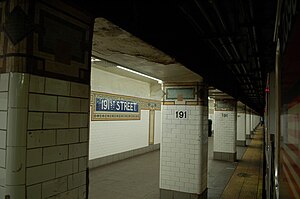191st Street (IRT Broadway – Seventh Avenue Line)
|
191st Street |
|||||||
|---|---|---|---|---|---|---|---|
| New York City Subway rapid transit station | |||||||
 |
|||||||
| Station statistics | |||||||
| Address | West 191st Street & Saint Nicholas Avenue New York, NY 10040 |
||||||
| Borough | Manhattan | ||||||
| Locale | Washington Heights | ||||||
| Coordinates | 40°51′18″N 73°55′44″W / 40.855°N 73.929°WCoordinates: 40°51′18″N 73°55′44″W / 40.855°N 73.929°W | ||||||
| Division | A (IRT) | ||||||
| Line | IRT Broadway–Seventh Avenue Line | ||||||
| Services |
1 |
||||||
| Transit connections |
|
||||||
| Structure | Underground | ||||||
| Depth | 180 feet (55 m) | ||||||
| Platforms | 2 side platforms | ||||||
| Tracks | 2 | ||||||
| Other information | |||||||
| Opened | January 14, 1911 | ||||||
| Wireless service | |||||||
| Traffic | |||||||
| Passengers (2015) | 2,713,440 |
||||||
| Rank | 186 out of 425 | ||||||
| Station succession | |||||||
| Next north |
Dyckman Street: 1 |
||||||
| Next south |
181st Street: 1 |
||||||
|
|||||||
|
|||||||
191st Street is a station on the IRT Broadway–Seventh Avenue Line of the New York City Subway. Located at the intersection of St. Nicholas Avenue and 191st Street in Manhattan, it is served by the 1 train at all times.
The West Side Branch of the first subway was extended northward to a temporary terminus of 221st Street and Broadway on March 12, 1906 with the station at 191st Street not yet open. The elevators and other work had not yet been completed, and 191st Street did not open to the public until January 14, 1911.
In 1948, platforms on the IRT Broadway–Seventh Avenue Line from 103rd Street to 238th Street were lengthened to 514 feet to allow full ten-car express trains to platform. Previously the stations could only platform six car local trains. The platform extensions were opened in stages. On April 6, 1948, the stations from 103rd Street to Dyckman Street had their platform extensions opened, with the exception of the 125th Street, which had its opened on June 11, 1948.
The 191st Street station has two tracks and two side platforms. There are also covered pedestrian footbridges connecting the two platforms, so people on the footbridges cannot see the tracks and platforms (and vice versa).
At approximately 180 feet (55 m) below street level, it is the deepest station in the New York City Subway system. In 1954, Victor Hess used the station to conduct experiments on the nature of cosmic rays, the discovery of which he won the 1936 Nobel Prize in Physics for; Hess's experiments at the station involved measuring the radioactivity of the granite deposits above the station. Despite this station's depth, the next station north, Dyckman Street, is just above ground level. This is because 191st Street is at nearly the highest point on the island of Manhattan and this station is deep in the Washington Heights Mine Tunnel, while Dyckman Street runs along a deep valley almost at sea level and its station is at the tunnel portal, despite the fact that both stations are at the same elevation above sea level.
...
Wikipedia




